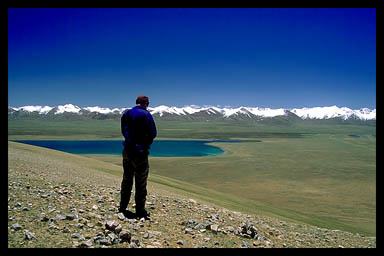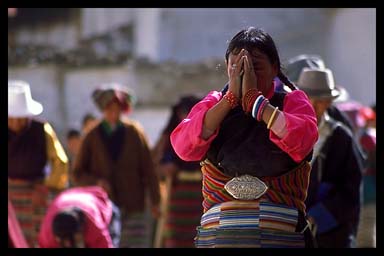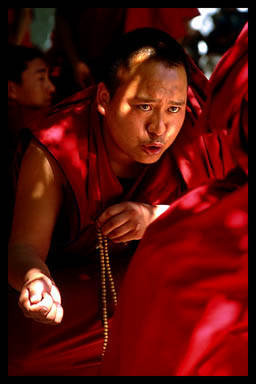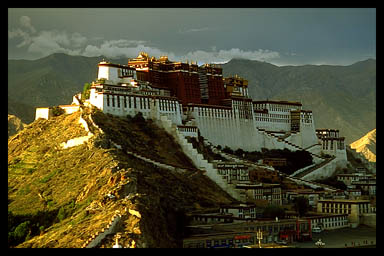Stories / Asia / Tibet |
||||||||
|
[ Seven Days in Tibet | Page 2 ]
On our second day on the road, I was surprised to find two new passengers in our minibus: a pretty young Tibetan woman and her four-year-old son. They appeared to be Tashi's friends and we were happy to give them a lift. Tashi seemed particularly pleased, spending the whole afternoon in the back of the bus chatting with our new passengers. When I wandered into the kitchen of our guesthouse the next morning, I found Tashi sound asleep on one of the benches along the wall, apparently still recovering from drinking a little too much Tibetan whiskey the night before. He woke a few minutes later with a muffled grunt and lifted his blanket to get up. I looked over and saw the young Tibetan woman lying next to him—she had paid for the lift—and she wasn't the last "hitchhiker" we picked up along the way. While Tashi seemed to have his own personal morality, most of the people I met in Tibet were fiercely religious. Buddhism is much more than a system of belief to the Tibetans, it encompasses the entirety of their culture and constitutes the very essence of their lives. At one monastery we visited, I met an old woman with a creased leather face and deep-set eyes who offered butter lamps to show her devotion. At another, an old man discreetly revealed his most valued possession, a photograph of the Dalai Lama, strictly banned by the Chinese.
One of the most important spiritual centers in Tibet is the Tashilumpo monastery, standing on a steep mountainside overlooking the city of Xigatse. It's a complex, rambling warren of chapels, shrines, and halls linked by mysterious alleyways and steep staircases. The day we arrived marked the first day of Saga Dawa, the holiest festival in Tibet, commemorating Buddha's birth and enlightenment. Thousands of pilgrims crowded the monastery to circumambulate an important temple. They walked around the temple clockwise in a hypnotic trance, reciting mantras and turning heavy copper prayer wheels as they passed. The most devoted pilgrims even prostrated around the temple, bowing down and lying on the ground with every step. Inside, the voices of a hundred monks echoed in a candle-lit room as they chanted in prayer to the heavy beat of a large drum. Later that night, walking around after dinner, we heard a different kind of beat: disco. The pulsing rhythm of dance music emerged from a dark stairwell. Upstairs, in a small, dimly-lit nightclub, a group of girls danced to a Swedish pop song as a handful of people watched. They eyed us suspiciously when we walked in, but the bartender seemed unfazed. He looked up, smiled, and led us to a corner table. As we ordered a round of drinks, Nathalie pulled out her Tibetan phrasebook and started talking to two Tibetan men at a nearby table ("What's your name?" "How old are you?" "Are you married?"). Confused, but charmed nonetheless, they offered her a shot of Tibetan whiskey. Meanwhile, I picked up a microphone and tried to charm the crowd with some karaoke. No one understood the lyrics, but it didn't take long for everyone to understand that I couldn't sing. I quickly passed the microphone to someone else. And later, when Michael Jackson took over the dance floor, Jim taught some break dancing moves to a group of bewildered Tibetans.
—————— Gazing out the window of our minibus the following afternoon, I was startled to see a Tibetan man jogging along the side of the road. Had the fitness craze finally reached Tibet? I looked around the bus and found everyone equally confused. Andy was about to ask our guide, "Tashi, why is that man jogging?" when we passed a small mule, also jogging along the side of the road. I suddenly realized: the man was chasing a runaway mule. We decided to intervene. As our driver pulled alongside the frightened animal, Andy positioned himself in the front of the minibus. Holding on to the bus with one hand, he leaned out of the open doorway, waited, then jumped from the bus and grabbed the mule around the neck. When the breathless man finally caught up, he nodded his head a few times, gestured something with his hands, and then walked away with his mule, perhaps still struggling to understand exactly what had just happened. These encounters are becoming more common as centuries old traditions collide with the realities of the modern world. Isolated in the heights of the Himalayas, Tibet remained closed to the influences of the outside world for hundreds of years. But today, in the fabled Himalayan kingdom, you're equally likely to see someone holding a prayer wheel as a mobile phone. Nightclubs outnumber monasteries. Stores sell yak cheese and Oreo cookies. And the voices of Eminem and Britney Spears are heard more often than monks chanting mantras. —————— The following day, as we approached Lhasa, we passed the crumbling ruins of a monastery demolished by the Chinese. When the Chinese invaded Tibet in 1949, there were over six thousand such monasteries and temples throughout the country with over half a million resident monks and nuns. But the Chinese authorities soon realized that religion was the principal obstacle to consolidating their control of Tibet and these monasteries were systematically destroyed. By 1976, only eight remained.
Nowhere is the legacy of Chinese occupation more evident than in Lhasa. The city is a sprawling gray grid of mid-rise apartment buildings erected by the Chinese. During the last twenty years, in a final ploy to consolidate their power over Tibet, the government has encouraged millions of Chinese settlers to migrate to Tibet, offering attractive salaries, interest-free loans and other incentives. As a result, over 70% of the city residents are now Chinese. Today, the Tibetan quarter is a segregated ghetto of crumbling heavy stone-walled homes, shops and businesses, zigzagged by stone streets. While the magnificent Potala Palace still towers above the city, it is no longer the religious and political nexus of Tibet. Largely abandoned since the Chinese occupation, it now functions as a tourist museum. Our guide preferred not to talk about the effects the Chinese occupation. "I don't like to talk about politics," he jokingly evaded our questions, later explaining that the government didn't allow him to talk about the Chinese occupation. But when someone once made the mistake of calling him Chinese, Tashi responded emotionally in a rare display of anger. "I am not Chinese," he snapped back, "I am TIBETAN." |
||||||||
Related Links |
||||||||
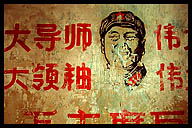
Tell me what you think about this story Read more travel stories See more photos from Tibet and Asia Lonely Planet map and guide to Tibet Green Hill Tours arranged the trip from Kathmandu to Tibet |
